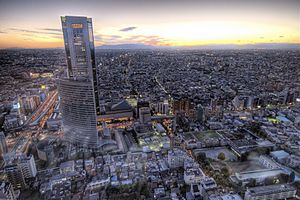New National Theatre Tokyo facts for kids

New National Theatre, Tokyo
|
|
| Address | 1-1-1 Honmachi, Shibuya-ku Tokyo Japan |
|---|---|
| Coordinates | 35°40′57″N 139°41′8″E / 35.68250°N 139.68556°E |
| Capacity | 1,814 (Opera House), 1,038 (Playhouse), 340-468 (The Pit) |
| Construction | |
| Opened | 1997 |
| Architect | Takahiko Yanagisawa |
| Website | |
| http://www.nntt.jac.go.jp/ | |
The New National Theatre, Tokyo (NNTT) (新国立劇場, Shin Kokuritsu Gekijō) is Japan's first and foremost national centre for the performing arts, including opera, ballet, contemporary dance and drama. It is located in the Shinjuku area of Tokyo. Since 1997 more than 650 productions were staged. There are about 300 performances per season with approximately 200,000 theatergoers. The centre has been praised for its architecture and state-of-the-art modern theatre facilities, which are considered among the best in the world. In 2007, the NNTT was branded with the advertising slogan: Opera Palace, Tokyo.
Contents
Background

The construction of the NNTT was completed in February 1997. Its first public performances took place in October of that year. The Tokyo Opera City Tower is connected to the theatre. It has concert halls, an art gallery, a media-art museum, office space, many restaurants and shops. The combined complex of the skyscraper tower and the theatre is called the "Tokyo Opera City".
Besides the public performances, various enterprises are undertaken, such as the young artist training programs (for ballet, opera, and theatre), theatre rental for other performing arts groups, performing arts-related exhibitions, public usage of its video library and book library, public performances for children and young students, backstage tours, and most importantly, international exchanges for performing arts events, etc. Moreover, The Stage Set & Design Centre (located in Choshi city, Chiba Prefecture), stores and exhibits previously-used stage scenery and costumes.
The arts management of NNTT, including the enterprises in above, is commissioned to New National Theatre Foundation (NNTF) from the independent administrative institution, known as The Japan Arts Council. NNTT is managed by several trust funds, government grants, admission revenues, and private donations from many supporting companies.
Theatres and performance facilities
- Steel reinforced concrete construction 5 floors above ground, 4 floors below ground
- Total floor area: 68,879 m2 (741,410 sq ft)
- Design: Takahiko Yanagisawa + TAK Architectural Institute
- The NNTT contains three main theaters.
Opera House (Opera Palace)
- Number of seats: 1,814
- There are 4 seats on the 1st to 4th floors.
- Mainly used for performances such as opera and ballet. There have been several concerts in the past.
- An orchestra pit with a maximum of 120 players (4 pipes) is permanent, and the depth can be adjusted according to the performance.
- A proscenium format with four stages. Using the upper and lower back stage mechanism, performances are often swapped.
- Opera subtitle devices are installed on the left and right sides of the stage, and are displayed in vertical writing.
- The theater solicited nicknames, and on March 29, 2007, the opera palace (OPERA PALACE Tokyo) was decided.
Playhouse
- Proscenium format: 1,038 seats, open format: 1,010 seats
- There are two seats on the first and second floors.
- Mainly used for performances such as theater and contemporary dance. Opera and ballet performances are also possible.
- There is also a four-stage stage and a temporary orchestra pit.
The Pit
- Number of seats: 340-468 seats
- Located on B1F.
- It has a movable stage and seat.
- It is used for performances of contemporary stage performances with open stage performances.
Other
- Information center (5F), rehearsal room (B2F), training room, roof garden (5F), etc.
New National Theatre Opera (NNTO)
In 2005, conductor Hiroshi Wakasugi was named artistic consultant to the opera division of the New National Theatre (also known as New National Theatre Opera, or NNTO). This post preceded his appointment as artistic director (i.e. Music Director of the New National Theatre) from September 2007. However, Wakasugi died in July 2009 and Tadaaki Otaka was appointed as 'acting artistic director' for 2009/2010.
The company's productions are usually conservative, and the principal lead singers are frequently drawn from a circle of top foreign opera singers from Europe and elsewhere. World-class Japanese singers who are famous abroad are often invited to sing lead roles as well. To introduce Japanese-related works into the operatic world, the NNTO has embarked on producing works such as Shuzenji Monogatari, composed by Osamu Shimizu (June 2009), and Ikebe Shinichiro's Rokumeikan (June 2010).
New National Theatre Ballet (NNTB)
The current Artistic Director of the New National Theatre Ballet (otherwise known as NNTB) is Asami Maki, who previously led the Maki Asami Ballet Troupe in Tokyo. Frequent foreign guest artists include Svetlana Zakharova and Denis Matvienko. The company's balletic identity draws from Russian, British, and French classical ballet traditions. David Bintley who is the current Artistic Director of the Birmingham Royal Ballet will lead the NNTB Company as the Co-Artistic Director with Asami Maki from 2010. The NNBT has performed at the Kennedy Center in Washington, D.C. (Asami Maki's Raymonda in February 2008), and will also perform Asami Maki's version of La dame aux camellias, as a guest company at the Bolshoi Theatre in September 2009. The NNTB is striving to become Asia's best ballet company as well as an internationally recognized company (Top 10) in the next few years.







